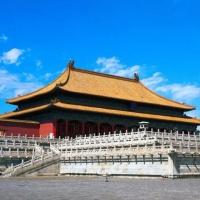The Forbidden City is also called the Imperial Palace in English, but it is most commonly known in Chinese as Gugong (means the "Former Palace"). Designated by the Chinese government as one of the country's foremost protected historical sites in 1961, it was officially renamed the "Palace Museum" (the name used by the R.O.C in 1924).



The Forbidden City is located in the center of Beijing Municipality, which once the home of the 24 emperors and their households of the Ming (1368-1644) and Qing (1616-1911) dynasties, and the ritual and political centre of the Chinese government. Built from 1406-1420, this palace complex exemplifies the traditional Chinese palatial architecture and consists of 9,999 surviving buildings including the magnificent palaces, halls, temples, turrets, towers, pavilions, rooms, imperial kitchens and storehouses etc.
Apart from their unique layout, these buildings have magnificent sights, their glowing yellow roofs against vermilion walls, not to mention their painted ridges and carved beams, all contributing to the sumptuous effect. For the purpose of defense, these buildings are circled by the high walls with military facilities and wide moats. As the world's largest collection of preserved ancient wooden structures the Forbidden City was declared a famous World Heritage Site by UNESCO in 1987.



Historically and artistically, the Forbidden City is one of the most comprehensive Chinese museums, which collects uncountable art treasures that belong to different dynasties including paintings, works of calligraphy, carvings, statues, pottery wares, porcelain wares, bronze or brass wares, handicraft articles, royal cultural relics, books, scriptures, lacquer wares, silk fabrics etc. (By the way, part of the museum's former collection is now located in the National Palace Museum in Taipei, they were split after the Chinese Civil War.)
In addition, something cannot afford to miss out in the Imperial Palace are the beautiful royal gardens, squares and stone bridges, which have many stories to be told.
Gugong has been an inevitable destination for those who first time visit Beijing because they arefull of enthusiasm about its mystery, the life of the royal families, nonpareil architecture and countless splendid treasures.
